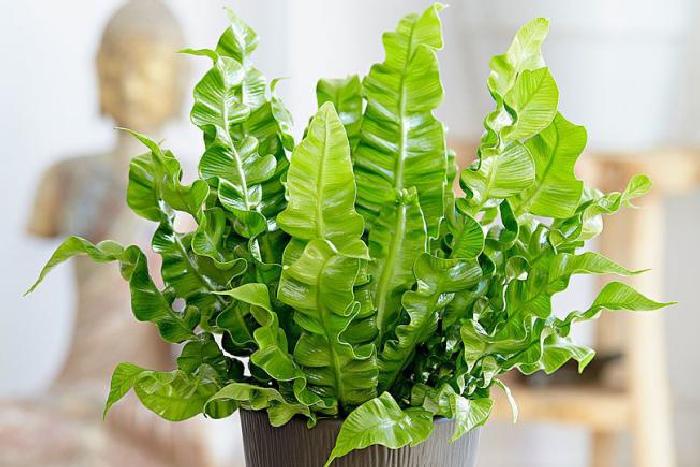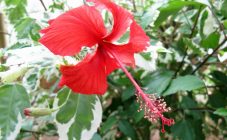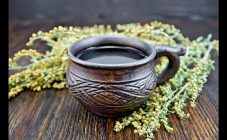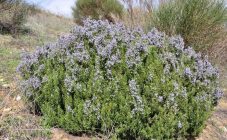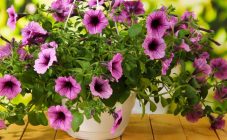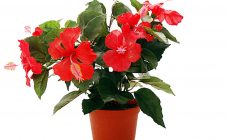Content:
Many growers like to grow Asplenium Nidus - a plant that is unpretentious and does not need special care.
History of appearance
The rainforests are considered the birthplace of Asplenium Nidus. Since the nineteenth century, flower growers began to grow it in glass boxes in greenhouses. Houses were then heated with stoves, and the air was dirty. Due to the gas pollution, Nidus died. Only in the twentieth century, when steam heating appeared, it became possible to plant a plant in a room.
Specific traits
Distinctive features:
- perennial herb,
- considered epiphytic,
- moderately cold resistant,
- belongs to the fern type.
Perennial Nidus ferns grow on trees, branches, stumps. There are about seven hundred varieties of this herbaceous plant. Distributed throughout the globe. For the first time Aspleniums Nidus appeared on the islands of New Zealand, Africa, Australia and Asia. They grew mainly in tropical forests.
External description
Asplenium Nidus has large glossy leaves, the root system is thick and creeping. The shape is sword-shaped. The flower itself resembles a fountain. Plant height in temperate latitudes is small. In tropical conditions - up to two meters. Coloring - bright green leaf plate. In the middle there is a sinewy formation, from which small strips diverge in different directions. The reproductive organs are located on the back of the leaf (like Asplenium Viviparous).
Outwardly, Nidus is very different from other domestic species, such as Asplenium Osaka (Anticum), Parvati, Susie. Also unlike Asplenium fern varieties for the garden.
Agricultural technology when growing at home
Landing
All land work must be done correctly so that the Aspleniums of Nidus do not die.
Planting instructions:
- Choice of location: no bright sun rays, window from the north, north-east or north-west side. If all the windowsills are sunny, then the flower is placed at a distance of three meters from them.
- Temperature and humidity: optimally + 21-24 degrees and 60%. At higher rates, the plant may dry out and die. The Asplenium flower does not tolerate drafts.
- The soil should be light, slightly acidic, loose, enriched with organic additives. For planting, a substrate is made: they take 2 parts of sod land, 3 - leaf, 3 hours of humus and an equal amount of peat and sand. Also add charcoal, sphagnum moss, pieces of clay.
If properly cared for, the plant will grow well in indoor spaces.
Asplenia home care
In the room, the plant is placed on a window on the north side - less UV rays are needed.For the fern, you need to maintain a temperature of 22 degrees and a humidity of 60 percent. Also, the Asplenium fern does not like draft and dustiness.
Watering
In summer and spring, the plant is watered abundantly, in winter - moderately. The earth ball should not dry out. Waterlogging Nidus is also undesirable. The most favorable watering option is to immerse the pot in a container. As soon as the soil is saturated with moisture, the flower is taken out of the water and the excess liquid is drained. Water is used standing at least twelve hours, since the plant does not tolerate chlorine.
Top dressing
From April to September, it is necessary to fertilize once a month. By the amount, about half the dose that is used for ficuses. Mineral and organic fertilizers are used for decorative deciduous crops.
Transfer
Asplenium is transplanted as soon as the roots no longer fit in the pot. This is done in the spring and also once a year.
The soil for plants should be slightly acidic. For a young flower, peat, leaf and humus soil, sand are mixed in a ratio of 2: 2: 2: 1 parts. For adult ferns, the following soil composition is prepared:
- Sod land - 2 hours;
- Leaf - 3 hours;
- Peat - 3 hours;
- Humus - 1 hour;
- Sand - 1 hour;
- Pieces of clay, sphagnum moss, charcoal are added.
While removing the flower from the pot, the roots are examined. If there are damaged ones, they must be removed. Good roots should not be damaged as they grow very slowly. Do not crush the land around the trunk, since the plant is very fond of loose soil. As soon as the flower has been transplanted, it must be watered with warm water and sprayed. Pick up the pot wider than the previous one.
How to rejuvenate Asplenium
Damaged and old leaves are cut off. If the plant is completely dry, you can remove all the shoots, and what remains, water it daily and spray it 2 times a day. After a while, new leaves will appear.
Reproduction
The plant reproduces:
- Brood buds. They are formed at the ends of the leaves, they are broken off and planted;
- By dividing the bush - in the spring, when transplanting, the flower is divided into several parts and placed in the ground;
- Reproduction by spores is the longest way. Spores are torn off the back of the sheet. The soil is sterilized. Spores are planted. For germination, special nurseries are created with optimal conditions.
Diseases and pests
The plant needs to be inspected regularly.
Pests:
- Aphid;
- Spider mite;
- Shield.
Means of struggle - the leaves are washed with soapy water and treated with insecticides.
Diseases:
- When the leaves dry, water and spray more often.
- When the plant withers, the roots may rot. You need to dry the soil and try not to overmoisten.
- If stains appear, fertilizers or soil composition are not suitable. Also, the cause may be diseases of Tuffin and Phillostik. It needs to be treated with fungicides. With a nematode, there are no means of control, the plant will have to be thrown out.
- The drooping foliage indicates low temperatures. You need to transfer the flower to a warm place.
- In case of pallor and loss of shine, you need to reduce the lighting for the plant.
Aspleniums Nidus are very beautiful and unpretentious flowers. They look very impressive both on the garden plot and in the room.
